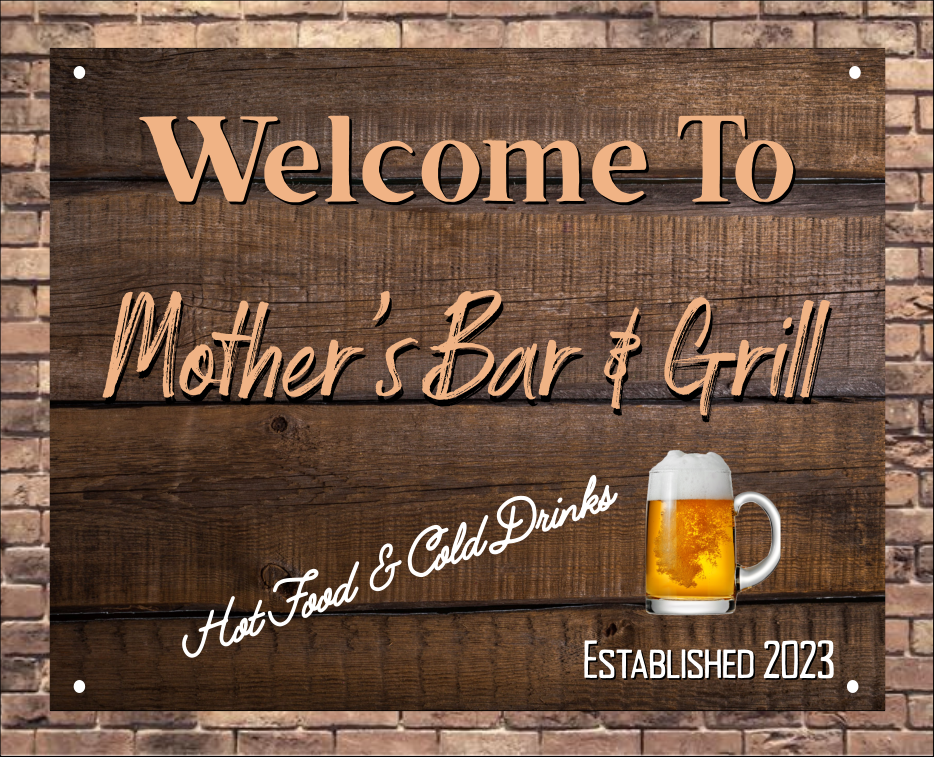Free Tips To Deciding On Pub Signs
Free Tips To Deciding On Pub Signs
Blog Article
What Are The Different Purposes Of Bar Signs?
The purpose of bar signs is a bit different. Bar signs have several different purposes. Branding
Purpose to establish and reinforce branding of the bar.
It is often a sign of the bar's logo, name and signature colors. It is designed to be an important feature that is representative of the overall style and theme of the bar.
Examples: Neon signs featuring the logo of the bar or custom-designed metal signs with the bar's name.
2. Information
Purpose : To provide patrons with important information regarding the establishment.
Features: Easy-to-read, clear text that communicates important information such as operating hours, Wi-Fi passwords and house rules.
Examples: Signs on the entrance to indicate the hours of operation or signs that indicate restrooms.
3. It's a decorative object.
Goal: To improve the visual appeal and ambiance of the bar.
Features: Helps to create the overall décor of the bar. Most often, it is more artistic and thematic. The bar may not have specific information or text.
For example: vintage advertisements for beer, humorous signs or quirky artwork.
4. Promo Codes
The purpose of this is to promote certain products such as services, events, or products.
Features: Eye-catching designs that highlight special deals as well as upcoming events, or menu items that are new. Some elements are temporarily or modifyable.
Examples: Chalkboards with daily deals, banners promoting happy hour deals, posters for upcoming events.
5. Directional
The purpose of this sign is to guide patrons within the bar.
Features: Clear instructions or arrows to guide the customer to the appropriate areas, like the bathroom, exits, or to the various locations in the bar.
Examples: Directional arrows in various seating areas.
6. Regulatory/Compliance
Obligation: Keeping in line with the legal requirements and ensuring safety.
Specifications: A sign that fulfills legal obligations. For example, indicating the smoking zone or occupancy limit, or emergency escapes.
Examples: "No Smoking", occupancy limit signs and emergency exit signs.
7. Interactive
Intention to connect with customers and create interactive experiences
Features: The elements that encourage patron involvement. Examples include write-on surfaces as well as digital interaction.
Examples include chalkboards to display customer messages or signs with QR codes that open to digital menus.
8. Thematic
Make a style or theme.
Features: Signs aligned with the theme of the bar, enhancing the overall atmosphere.
Examples: Pirates-themed signage on an ocean-themed bar. Rustic wooden signs at a pub with a theme of country.
9. Menu
Scope: To showcase the bar's menu items.
Features The list of beverages and food items is displayed clearly, usually with prices. Can be static or changeable.
Examples include: Digital screens that show rotating menu items, wall-mounted drink menus.
Each bar sign is created to serve a particular purpose. Its design is based on the role it plays in the bar. When they understand the different types, bar owners will be able decide and install the signs in a way that improves patrons' experience as well as meets their operational requirements. Read the most popular gin bar sign hints for website tips including pub signs to buy, personalised bar signs, pub signs made, the staying inn bar sign, bar pub signs, bar pub signs, home made bar sign, hanging tavern sign, personalised bar signs, outdoor home bar signs and more.
How Are Bar Signs Different In Terms Of Readability?
The readability and size of bar signs is affected by several factors such as font choice and contrast of colors, location and lighting. This article will discuss how each of these factors affects the readability of bar signs. Font Choice
Signs are distinguished by the typefaces they employ.
Readable Fonts: Simple, sans-serif fonts like Arial, Helvetica, or straight serif fonts like Times New Roman.
Stylized Types: Decorative and script fonts may be difficult to read in low-light or from afar.
Impact A clear and legible font allow people to read information.
2. Font Size
The sign's characteristics include Text size.
Large Fonts. They are more readable when seen from a distance. Perfect for exteriors and primary signs.
Small fonts work well for menus as well as tabletop signs.
Impact: The right font size makes it easier to read the text at different distances.
3. Color Contrast
Characteristics: the difference between the hue of the text and the background.
High Contrast: Dark text with a lighter background or lighter text on a darker background (e.g. black and white, or white on black).
Low Contrast: Similar colors between background and text may make the text hard to read (e.g. grey against black).
Impact: High contrast enhances readability and makes sure that text reads clearly.
4. Lighting
Characteristics of the sign: how the sign is lit.
Well-Lit Signs - Backlit or Front-lit signs increase visibility in low-light conditions.
Signs with poor lighting Signs that aren't adequately illuminated can be difficult to read in the dark or when they are the lighting is dim.
Effect: Proper lighting will ensure that signs are clearly visible and legible at all times, especially in dark environments.
5. Material and Finish
Particulars: The kind of finish and material that is that is used to create the sign.
Matte finish reduces the glare. Text will be much easier to read.
Glossy Finishes - Cause the appearance of glare when exposed to direct light which makes it hard to read.
Impact: The best finish and material will enhance readability and reduce glare.
6. Text Layout
Characteristics: Text arrangement on the sign.
Clear Hierarchy. Information can be organized with headings, subtitles and the body text.
Signs with a messy layouts are difficult to comprehend.
The impact: A well-organized, simple layout makes it easier for customers to find and comprehend the details.
7. Viewing Distance
Particulars: Distance from where the sign is read.
Long Distance: Bigger text and high contrast are crucial.
Short Distance: Although smaller fonts are acceptable, clarity and simplicity are still crucial.
Impact: Signs are created to be read with the intended reading distance in mind.
8. Placement
Particularities include the position of a sign inside the bar.
The ideal position is at eye level, clear of obstructions and well-lit.
Poor placement: high up in the air, obscured by objects or in areas that have poor lighting.
Effectiveness: Properly placed signs will make sure that people can easily read and see them.
Signs that are easy to read
Exterior Signs
Characteristics: Large text, high contrast and well-lit (e.g. backlit, neon) and prominently placed.
Impact: Draws customers in by drawing interest.
Menu Boards
Particularities Highlights: Bright, high contrast chalkboard, large head-posts with high contrast.
Effect: It's simpler for customers to make a decision and review their orders. They will enjoy an easier experience.
Directional signs
Specifications: Clear and large text with simple Arrows. A high contrast. Strategically placed at eye level.
Impact: Allows patrons to navigate the space effortlessly which improves the overall flow and satisfaction.
Signs for Promotion
Characteristics include: bold text to promote High contrast, well lit and placed in high traffic zones.
Impact: Promotes customer engagement through effective communication of special promotions and events.
Factors Affecting Readability
The environment can influence how easy it is to read signs. Ambient lighting, mood of the establishment and its overall appearance all affect this. Bright, well-lit environments enhance the readability of signs.
Patron Movement - When there are a lot of people in bars, signs need to be easily understood by patrons that move around. In these situations, large text with a high contrast is beneficial.
Use formats that are easy to read and keep up-to-date (e.g. digital chalkboards or display screens) for signage that change regularly.
By making sure they pay attention to these aspects, bar owners can ensure they display signage that is not just visually attractive but also highly comprehendible, enhancing the overall experience for customers. Check out the best bar sign for site tips including garden pub signs, outdoor personalised bar sign, staying inn sign, the staying inn sign, pub signs for garden bar, home bar pub signs, personalised sign for bar, the staying inn pub sign, personalised home pub sign, pub signs personalised and more.
What Are The Differences Between Bar Signs In Terms Of Regulations?
Signs for bars are subject to various regulations that are imposed by state, local and federal authorities to ensure public safety, aesthetic standards, and compliance with zoning laws. What regulations apply to bar signposts? Size and Regulations on Positioning
Zoning law: It is a set or rules that determine where signs may go and their height, size and distances from property lines and road, as well as other structures.
Historic Districts: Signs could be limited to maintain the historical character of specific districts. This may include restrictions on size, design and materials.
2. Illumination Restrictions
Light Pollution Regulations may limit the brightness and color of illuminated signs to maintain the nighttime ambience and reduce light pollution.
Safety: Signs should not cause glare, or a distracting light that could cause danger to drivers or pedestrians. This is especially true near roads.
3. Signage content
Alcohol Advertising Certain jurisdictions have limitations on alcohol-related advertising. This includes a ban on certain imagery or content that attracts minors or encourages excessive drinking.
Health warnings. Laws may require to display signs that warn of risks associated with smoking cigarettes or alcohol consumption.
4. Historic Preservation Regulations
Architectural Compatibility: Signs that are placed in historic districts should be in harmony with the architectural style and characteristics of the district, usually needing approval from preservation boards or commissions.
Materials and Design: Restrictions may be applied to the materials, design, and color scheme of signs to ensure historical integrity.
5. Sign Permitting Process
Permit requirements: Before putting up or altering signs, bar owners are required to get permits. This could mean submitting plans, paying fees and getting approval from local authorities.
Code Compliance: Signs must to conform with the building codes as well as fire safety rules as and accessibility standards in order to maintain public safety and ensure accessibility for people with disabilities.
6. Repair and removal of signs
Maintenance Requirements Bar owners need to keep signs in good shape make sure they are structurally sound and free of any dangers. Additionally, they must be compliant with the regulations.
Abandoned Signs - Regulations can govern the removal of abandoned and dilapidated signage to avoid blight while maintaining the aesthetics of the area around it.
7. Digital Signage Regulations
Content Restrictions: Laws can limit the content displayed on digital signage, such as by preventing flashing lights and offensive imagery.
Limitations on the Operational Signs To reduce visual clutter, regulations could restrict the brightness of digital signs, their motion or the frequency at which they change.
8. Enforcement and Penalties
Inspections. Local authorities perform periodic inspections of signage to verify the compliance. Citations for violations are issued.
Penalties: Penalties for non-compliance may include fines, citations for removal or modify signs, or legal actions.
9. Signing Process
Bar owners may apply for Variances: Bar owners may request variances to deviate the standard sign regulations. They must show they have a legitimate reason for the deviation and minimize any negative impact on aesthetics, safety, or security.
Public Input. The issue could need public hearings or participation from the community. This may include neighbors, property owners, business associations, and/or residents of communities that are adjacent to each other.
10. Community Engagement and Input
Public Consultation - Certain jurisdictions include community members in the design and the implementation of signage regulations through organizing public meetings or surveys.
Sign regulations may include provisions that enhance the appearance of signs, boost local businesses, or aid in revitalizing an area.
Being aware of and adhering to signage regulations will help bar owners ensure their signs contribute positively to the surrounding community, abide with legal requirements and minimize the chance of being fined and penalties. Follow the top garden bar signs url for site advice including pub signs made, staying inn sign, large bar signs, bar signs for home, the pub sign, large pub sign, personalised home pub sign, hanging pub signs for sale, personalised cocktail sign, personalised pub signs and more.